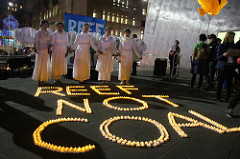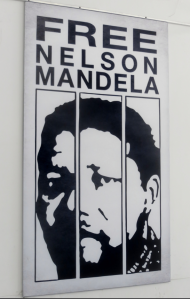Symbolic politics is a familiar part of everyday politics, including climate politics.

When Tony Abbott mounts a scare campaign about the Great Big New Tax on Everything and the Gillard government fails to establish imagery and narratives in the public mind in response, the conditions for abolishing Australia’s carbon tax have been created. Trump’s “Build the Wall”, “Mexican immigrants”, “Drain the Swamp” and “Hillary’s emails” energised enough US voters to make him President. Politicians from Obama, JFK and Hawke to Thatcher, Reagan and Howard have exerted power through the images that they project – of themselves and of social issues. When they do this, they are exerting a distinct kind of power, separate from economic, institutional or parliamentary power.
Symbolic politics is central to the work of social movements, including the climate movement.
When the ‘Pacific Warriors’ confront coal ships in the port of Newcastle in their canoes, they dramatise the contribution of Australia’s coal exports to climate change, gaining international media coverage, galvanising the climate movement, and building the case for ending Australia’s coal industry.

(Mohamed Seeneen, 2009)
When the Maldives government holds an underwater cabinet meeting to draw attention to climate change, they gained global media attention ahead of the international climate talks held in Copenhagen in 2009.
When people and institutions divest from the fossil fuel industry, they are not only exerting financial pressure, but also sending a message about the legitimacy and social license of fossil fuels: for many campaigners, the stigmatisation of the industry is the primary goal of divestment campaigning.
If “the public imagination” that is engaged by images, narrative and political theatre matters for politics, and if the “symbolic dimension of power” is a distinct “area” where politics is worked out, then it is as important to ask “how well are we applying symbolic politics?” and “how are our opponents using images and stories?” as it is to ask “how well are we doing community organising?”, and “how well are we building alliances and strengthening networks?”
______________

What makes social movements move, and how do they “capture” and shift the public imagination? Symbolic politics is important both for galvanising a movement and reaching the broader public. Images, narrative and political theatre condense and focus a sense of what an issue is and why it is important. Often, we think in images and narratives, more than we do in assertions and propositions.
Public perceptions and attitudes often only become politically powerful when they become symbolically-charged. In the ‘symbolic power’ dimension of political power, the public imagination is fired or ‘captured’, constituencies for change are built, and issues that might otherwise seem remote and complex can be infused with political significance.
A focus on symbolic politics adds to approaches to political power that explain politics in terms of institutions, structural factors, political parties, “people power” and economic forces. Obviously , these factors powerfully influence climate politics, however climate politics is also about the range of factors that shape the political judgments made by the real people whose action or inaction affects political outcomes. Among other things, politics is about what moves people to act, identity, identification, emotion – what people feel strongly about, and how people “see” the world.
Images, narrative and political theatre connect with these subjective aspects of politics, motivating and energising political support, or offsetting and diminishing opposition. Images, narrative and political theatre give content to identity and provide a focus for what moves and motivates people.
When looking at why Trump won the 2016 US election, why Abbott prevailed over Gillard, why fears about immigration can become a vortex which consumes political energy and diverts attention from other issues – including climate change – it is important to look at the role of symbolic power. In the case of climate politics, this includes assessing whether the symbolic power of the fossil fuel industry and its supporters is being effectively countered with the climate movement’s own images, narratives and political theatre, and how strengthening the movement’s symbolic power may increase its chances of achieving its political goals. Symbolic power wielded by opponents needs a compelling symbolic answer, as well as well-reasoned propositions and policy statements.
____________________________________________
There is a rich tradition of social movements using symbolic action to inspire their members and reach the public, often ‘cutting through’ apathy and denial. Social movement history shows how important it has been to re-define the meaning of events, often through iconic actions and images, for building movements, reaching the public, and achieving change.

Symbolic actions such as Gandhi’s Salt March, the Freedom Rides and lunch counter sit-ins during the civil rights movement in the USA, and the Aboriginal Tent Embassy in Australia have energised social movements and acted as a catalyst for dramatic social change. The British antislavery movement used imagery of conditions on a slave ship and a boycott of sugar from slave plantations to focus public attention on the meaning of slavery. Police reaction to the Sharpeville massacre and the Soweto uprising and the imprisonment of Nelson Mandela were made metaphors for the wider reality of apartheid: they were used by the anti-apartheid movement to communicate about apartheid to the world.
Symbolic communication can condense the meaning of a complex issue into an image that people recognise and respond to.
It can make issues visible, capture the public imagination, build momentum for change and re-shape culture and society. Working hand-in-hand with community organising and economic pressure, symbolic communication is often a key factor in achieving social change.
Keck and Sikkink distinguish
Alison Brysk (1995) writes:
We think about politics in stories, and our consciousness is changed when new stories persuade us to adopt a new paradigm. Collective action itself then involves a kind of storytelling or political theater, performing the new paradigm to persuade others. Stories that work rewrite history because they contain the elements of successful communication-legitimate speakers, compelling messages, and satisfying plots.
In The Civil Sphere, Jeffrey Alexander (2006) reflects on how the civil rights movement in the USA achieved change:
the Civil Rights movement engaged not only in instrumental but in symbolic action, creating a compelling, arresting, existentially and politically encompassing narrative, a social drama with which the audience, the members of northern civil society, could identify and through which they could vicariously participate. It is a fascinating and highly revealing fact of the academic literature on the movement that even those most interested in portraying civil rights leaders and masses as strategic, purposive, practical, and hard-headed continually employ the term “dramatic” to identify the movement’s major events and activities…
In The Meanings of Social Life: A Cultural Sociology, Alexander writes that collective emotions and ideas are important
precisely because it is such subjective and internal feelings that so often seem to rule the world. Socially constructed subjectivity forms the will of collectivities; shapes the rules of organizations; defines the moral substance of law; and provides the meaning and motivation for technologies, economies and military machines.”(2003, 5)
Giving weight to these dimensions takes nothing away from the importance of factors like community organising, economic interests and media power. All of these, together with symbolic politics, are part of the whole story. However, the role of images, narratives and political theatre is often overlooked or treated as secondary. It is worth paying more attention to – and factoring in when assessing what is happening in a political situation, and when planning a response.
One thought on “Symbolic politics: what it is & why it matters”